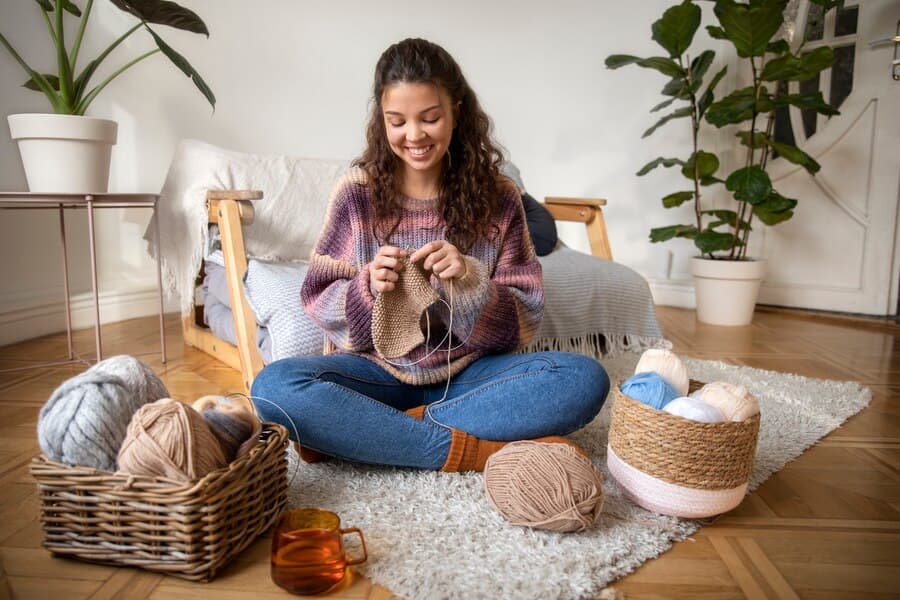Introduction to Yarn Joining Techniques
Joining new yarn in knitting is a fundamental skill that enhances the versatility and creativity of your projects. Whether you’re adding a new ball due to yarn shortage, introducing color stripes, or transitioning to a different yarn, understanding various joining techniques is essential. This guide presents 10 diverse methods, catering to different yarn types and knitting styles.
Overview of 10 Yarn Joining Methods
The selection of yarn joining methods ranges from straightforward to nearly invisible techniques, accommodating various yarn textures and project requirements. Each method has its unique advantages, suitable for different fibers and knitting contexts, such as color work and knitting in the round.
Detailed Steps for the Simple Knot Method
The simple knot method is a time-tested approach for joining yarn, especially effective at the end of a row. It’s a universal technique compatible with all yarn types and most knitting projects.
Simple Knot Method Instructions
- Stop knitting after completing a row when your yarn is nearly finished. Estimate
the yarn length needed to complete the row, usually about three to four times the width of your project.
2. Begin the new row with a new yarn ball, leaving a tail of approximately 5 inches.
- Knit the first few stitches, which may be loose. Gently tug on the tails to tighten;
- After knitting about 10 stitches, tie the ends of the old and new yarn in a loose knot;
- Continue knitting as per your pattern. Once the project is complete, carefully untie the knot;
- Weave in the yarn tails on the wrong side of the project for a neat finish.
Tail Weaving and Finishing Techniques
For a polished look, weave in the yarn tails on the project’s wrong side using a tapestry needle. If the project involves seams, such as in a sweater, the tails can be concealed within the seams. Ensure the woven ends are secure and inconspicuous for a professional finish.
Tips for Yarn Joining in Different Projects
- When working on projects like sweaters, consider hiding yarn tails in the seams for a cleaner look;
- For projects knitted in the round, change yarn at a less noticeable spot to maintain continuity;
- Review our detailed tutorial on weaving in ends for additional guidance and techniques.
Comparative Table: Yarn Joining Techniques in Knitting
| Technique | Suitability | Difficulty | Ideal for | Knots/Weaving Required |
|---|---|---|---|---|
| Simple Knot | Universal | Easy | Quick fixes | Knots |
| Russian Join | Smooth Yarns | Intermediate | Invisible joins | Weaving |
| Spit Splice | Feltable Yarns | Easy | Seamless joins | None |
| Magic Knot | Most Yarns | Easy | Secure joins | Knots |
| Weaver’s Knot | Slippery Yarns | Intermediate | Strong joins | Knots |
| Felted Join | Wool Yarns | Easy | Wool projects | None |
| Overlap Method | Delicate Yarns | Easy | Delicate fabrics | Weaving |
| Braided Join | Colorwork | Intermediate | Multicolor projects | Weaving |
| Loop Method | Circular Knitting | Easy | Knitting in the round | Weaving |
| Twist Method | Varied Textures | Easy | Textured yarns | Weaving |
Integrating the German Short Row Heel in Knitting Projects
While exploring various yarn joining techniques is essential for overall knitting proficiency, mastering specific methods like the German short-row heel can significantly enhance specific projects, such as socks. This heel technique, known for its snug fit and aesthetic appeal, can be seamlessly combined with the yarn-joining methods discussed earlier.
Understanding the German Short Row Heel
The German short-row heel involves creating a series of short rows to shape the heel of a sock or similar garment. This technique is distinguished by its ability to provide a comfortable, form-fitting heel, making it a popular choice among knitters.
Applying the German Short Row Heel
- Begin by working short rows to shape the heel, using the appropriate yarn joining technique to transition between yarns or colors;
- Employ methods such as the simple knot or Russian join for secure and discreet yarn transitions within the heel;
- Focus on maintaining consistent tension and stitch alignment for a smooth, professional finish.
By combining yarn joining methods with the German short-row heel technique, knitters can create socks and other footwear with impeccable detail and comfort. The heel’s structure and the seamless yarn transitions contribute to a high-quality, durable final product.
Conclusion
Mastering various yarn joining techniques is crucial for knitters looking to enhance the quality and appearance of their projects. Understanding the right method to use based on the yarn type, project requirements, and desired finish can significantly improve your knitting experience. From simple knots for quick fixes to more advanced methods like the Russian join for invisible transitions, each technique offers unique benefits that cater to different knitting scenarios.
The choice of technique not only affects the durability and aesthetics of the finished project but also impacts the knitting process itself. By selecting the appropriate method for each situation, knitters can ensure seamless transitions, maintain consistent tension, and achieve a polished, professional look.
